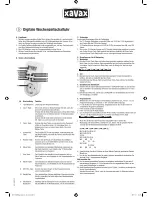
M e r i d i a n I I U s e r M a n u a l
116
C H A P T E R T E N
117
M e r i d i a n I I U s e r M a n u a l
R E A R - P A N E L I / O
frequencies from 1 Hz to 10 MHz in 1 Hz steps are available, including 1.544 Hz or 2.048 Hz. The
selected frequency is phase locked to the system oscillator and is not aligned with system time. The
synthesized frequency can be changed via the front-panel display by navigating to Main Menu >
Option I/O > Sys I/O > DDS (see
Chapter 12 - Front-Panel Keypad/Display
). Or, you can change
the synthesized frequency via the network or serial port by using console command
systemiocon-
fig
(see
Chapter 3 - Console Port Control & Status
). When you change the selection, it affects all
DDS outputs in Meridian II. For signal definition see
Appendix K - Specifications, Optional DDS
Sine Wave Module
. (This module may not be field-installable, depending on whether your Meridian
already has a DDS installed.)
�������������������������������������
�����
�����
�� ���
� � ���
Telecom Clock Module
The Telecom Clock Module is a “plug-and-play” option that adds two or three outputs to your Merid-
ian II. Two outputs are available for any combination of T1, J1, E1 and Composite Clock. An alarm
relay output is also available as an additional option. When Meridian II is configured with any of the
available oscillator upgrades, it can operate as a Primary Reference Clock, providing high-stability
Building Integrated Timing Supply (BITS) clock signals directly to digital equipment. For signal
definition see
Appendix K - Specifications, Optional Telecom Clock Module
.
SAFETY WARNING
This option does not incorporate over-voltage protection suitable for connection to the public telecommuni-
cations network. Do not connect to any wiring that leaves the building.
The rear-panel outputs are labeled with their configuration (E1, T1, J1, 64kCC, Alarm). Examples
are below. This configuration cannot be changed but can be viewed via the front-panel display by
navigating to Main Menu > Option I/O > OptCardx (where x = 1-5). You can also view the Telecom
Clock Output configuration via the network or serial ports by using console command
pluginopts
,
SINE WAVE MODULE (WITH OSCILLATOR AND 10 MHz)
LPN MODULE (WITH OSCILLATOR AND 5 &10 MHz)
DDS SINE WAVE MODULE
Summary of Contents for Meridian II
Page 2: ......
Page 20: ...M e r i d i a n I I U s e r M a n u a l This page intentionally left blank...
Page 139: ...119 M e r i d i a n I I U s e r M a n u a l R E A R P A N E L I O...
Page 216: ...M e r i d i a n I I U s e r M a n u a l 196 A P P E N D I X J...
Page 235: ...215 M e r i d i a n I I U s e r M a n u a l S P E C I F I C AT I O N S...
Page 236: ...M e r i d i a n I I U s e r M a n u a l 216 A P P E N D I X K...
Page 239: ......
















































